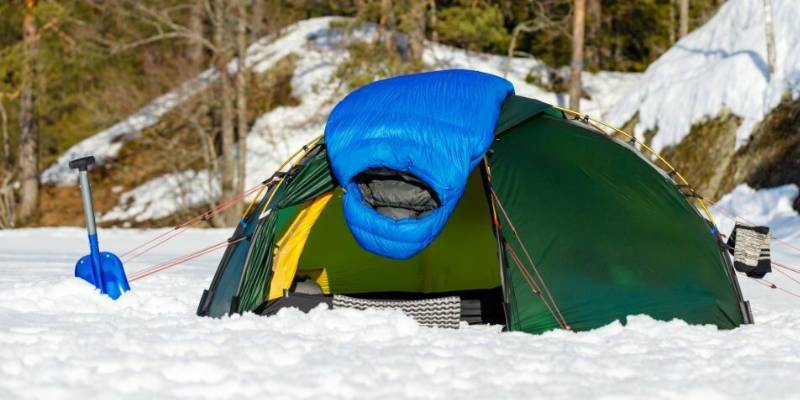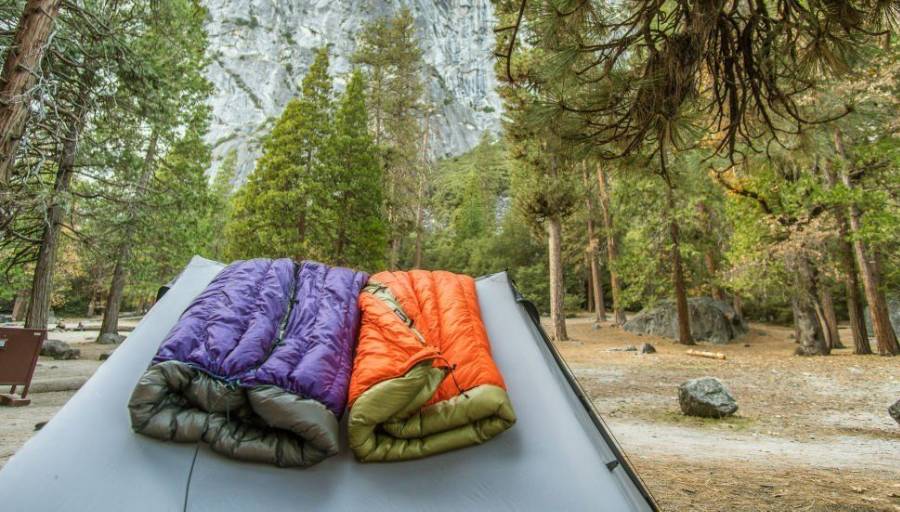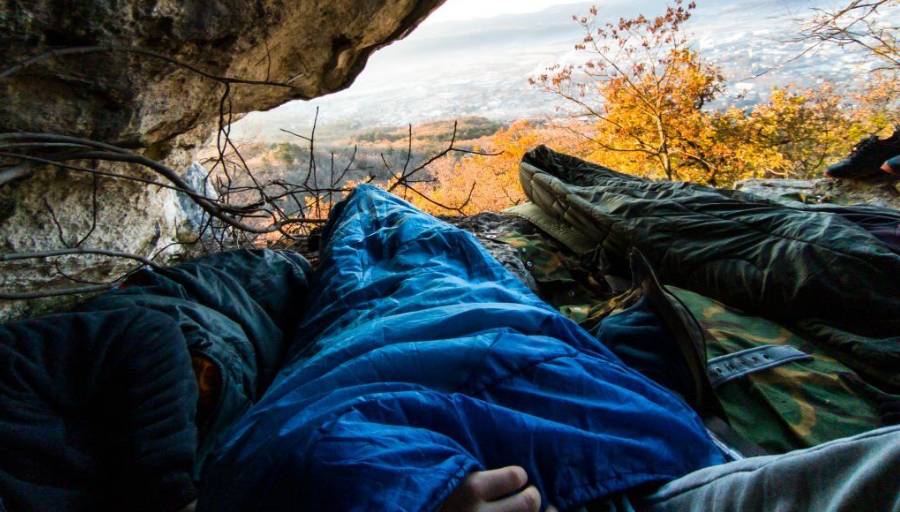Down vs Synthetic Sleeping Bags
When shopping for a new sleeping bag, a key decision is choosing between down and synthetic options. This guide compares down and synthetic sleeping bags, highlighting the major advantages and disadvantages of each material. We’ll explain how the insulation in both types works and how to assess their quality. Finally, we’ll discuss when it’s worth investing in a synthetic fiber sleeping bag versus a down one, helping you determine which option best suits your needs.
What is Down Filling in Sleeping Bags?

Down is recognized as a high-quality insulation material for sleeping bags, but it’s important to note that down differs from regular bird feathers. Down refers to the soft, fluffy plumage found beneath the outer feathers of waterfowl like ducks and geese.
In down sleeping bags, insulation is formed through the formation of air chambers that trap heat. Many manufacturers now use a combination of down and feathers in their sleeping bags, with the mixing ratios varying significantly. In premium models, the proportion of feathers is typically around five percent, primarily added for stability rather than insulation.
The following factors play a strong role in the quality of the down:
- Bird species
- The age of the animals
- Time of plucking
- Climate at the place of origin of the animals
- Nutrition of the animals
Waterfowl from colder regions yield higher-quality down filling, with goose down generally superior to duck down. Due to its higher cost, duck down has become more common in production in recent years. Additionally, the age of the birds plays a role in down quality; older animals produce fuller and more stable down.
A key indicator of down quality is its fill power, which measures how much an ounce of down (approximately 28.34 grams) expands under specific pressure in a cylinder. The quicker and more voluminous the expansion, the better the insulation performance of the down.
This filling power of the down (also “loft”) is given in cubic inches:
- Usable fill power from 500 cubic in.
- Good bulking power from 650 cubic in.
- From 900 cubic in. excellent fill power, top models
The highest-quality sleeping bags feature a mix of up to five percent small feathers and 95 percent down, offering an excellent fill power of 900 cubic inches or more. For a functional sleeping bag, the small feather proportion should not exceed 20 percent. Most duck down, on the other hand, has a maximum fill power of around 800 cubic inches. When choosing a premium down sleeping bag, consider the species of bird used and the fill power.
An 800 fill power down sleeping bag requires less down than a 700-fill model to provide the same level of insulation, resulting in a lighter weight. This reduced weight, along with a smaller pack size, is particularly appealing for backpackers. Furthermore, down insulation can absorb body moisture more effectively than synthetic materials, enhancing comfort during use.
While down filling has many advantages, it also has drawbacks. The primary concern is that down should not get wet, as moisture can significantly reduce its loft and insulating properties. Therefore, it’s essential to minimize washing and cleaning of down sleeping bags to maintain their performance.
Above all, high-quality down sleeping bags require a certain discipline – for example avoiding dirt and washing too often. Another disadvantage is the often incomprehensible treatment of the animals: plucking is painful for the animals, so many manufacturers state that they only use slaughtered animals to get down.
| Advantages | Disadvantages |
|
|
What is synthetic filling in sleeping bags?

The insulating capacity of synthetic fiber fillings in sleeping bags comes from the loft formed by synthetic fibers, primarily polyester, which form air chambers to repel the cold. For this insulation to be effective, the surface of the synthetic fibers must be as smooth as possible, allowing them to expand properly. To achieve this smoothness, a layer of silicone is applied to the fiber’s surface. This prevents the fibers from impeding each other or getting tangled. Since synthetic fibers are inherently rough, this silicone coating is essential for producing high-quality synthetic filling in sleeping bags.
However, the manufacturing costs increase with the robustness and smoothness of synthetic fibers. These desirable properties significantly impact the quality of the insulation, which explains the noticeable price differences between cheap and expensive synthetic sleeping bags. Higher-quality synthetic bags often contain better materials and production techniques, resulting in superior performance and durability.
While cheap models quickly lose their fill power and become unusable, premium synthetic fiber fillings are durable and promise excellent insulation against the cold. Overall, a sleeping bag with a synthetic fiber filling is significantly cheaper than a down model. The price is a decisive argument, especially for campers on a tight budget.
The key advantages of synthetic fiber sleeping bags over down fillings include faster drying times and effective insulation even when damp. As a result, high-quality synthetic fillings tend to have a longer lifespan, and they retain their loft better through regular washing.
| Advantages | Disadvantages |
|
|
What good is the mixture of fibers and down?

Some manufacturers intentionally market jackets and sleeping bags that combine down and synthetic fibers. In certain sleeping bags, they mix and distribute down and synthetic fillings throughout the entire length. Other synthetic down models capitalize on the specific advantages of each material: some sleeping bags feature robust synthetic fibers in the lower part while using particularly lofty down on top.
| Advantages | Disadvantages |
|
|
Down vs synthetic sleeping bags: which filling is right for me?
Due to the individual advantages and disadvantages of the different fillings, the purchase decision should be made based on the following criteria:
- Budget
- Kind of trip
- Local climate and weather
- How much space can the sleeping bag take up?
- How light does the sleeping bag have to be?
Campers on a tight budget should almost always opt for the more affordable synthetic fiber sleeping bag. This choice is partly due to the complex care required for down fillings, where mistakes can be costly because of their high sensitivity. However, if you are a backpacker who travels light, high-quality down is the better option, as it helps save space and weight. Furthermore, down insulation is ideal for cool, dry regions, making it a preferred choice for winter campers.
Festival campers should choose synthetic fiber sleeping bags. Mishaps can occur at lively music festivals, where spills and stains are common. Synthetic fiber fillings excel in these situations, as they can withstand frequent washing without compromising insulation. Also, allergy sufferers often prefer synthetic fibers, which are generally allergy-friendly.
Frequently Asked Questions (FAQs)
Which is better for wet conditions: down or synthetic?
Synthetic sleeping bags have an advantage in wet conditions. They retain insulating properties when damp, whereas down sleeping bags lose their effectiveness when wet. This makes synthetic bags a more reliable choice for humid or rainy environments.
Can synthetic sleeping bags be compressed as easily as down bags?
Synthetic bags are less compressible compared to down bags. Down’s natural loftiness allows for excellent compression, making it easier to pack in a smaller space. However, advancements in synthetic insulation technology have improved compressibility in recent years.
Which type of sleeping bag is more suitable for long-term use?
Down sleeping bags generally have a longer lifespan than synthetic ones when properly cared for. They retain their loft and insulation properties for an extended period, making them a superior choice for prolonged use across multiple seasons.





